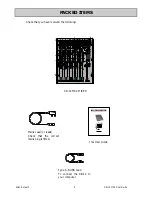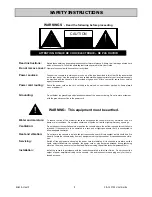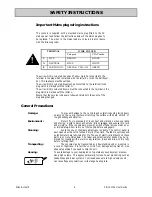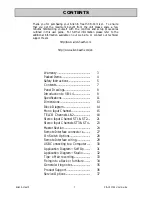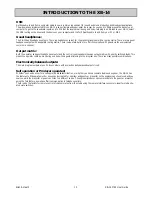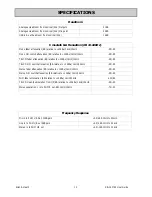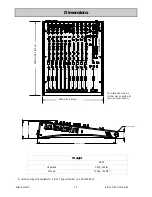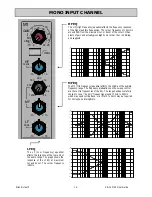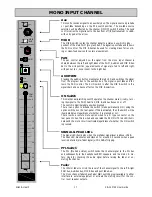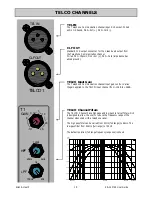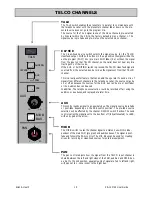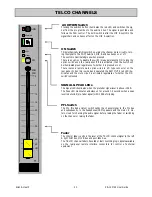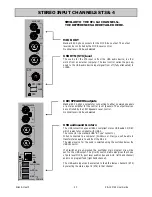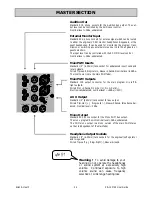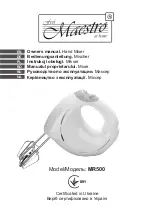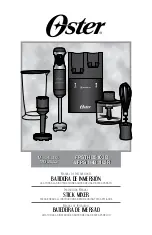
Allen & Heath 9 XB-14 MK2 User Guide
INTRODUCTION TO THE XB-14
Background overview:
The Allen & Heath XB-14 mixer has been carefully and lovingly designed in the beautiful county of Cornwall in the UK and is manufac-
tured alongside a wide range of professional audio mixing consoles. Many of the components used in the XB-14 are exactly the same as in
the larger Allen & Heath products and the construction methods are also very similar utilising individual vertically mounted channel circuit
boards with each rotary control fixed with a metal nut to the front panel. This provides a very robust product that will resist damage and
give years of reliable use. It also makes servicing much easier should it be required, with the ability to remove one particular channel from
the mixer at a time, or easily change a fader.
The audio circuitry is based on years of continual development and refinement , the performance of all the elements within the mixer
scrutinised and perfected to ensure the very best sound quality possible.
Multi-application:
The XB-14 is great for a range of applications from small radio or internet broadcast studios, or for larger studios with multiple rooms,
for hospital radio, university radio and community radio broadcast applications. The XB-14 has a wealth of features specifically designed
for broadcasters, things like telephone communication modules for telephone callers, mic fader start sensing for external connection and
internal automatic muting of the speaker outputs, stereo channel start/cue outputs for CD deck transport control, separate headphones
mix & outputs for guests, an audition bus…. The list goes on!
Mic/Line Pre-amps:
The XB-14 pre-amps use a two stage design, with carefully controlled amounts of gain in each stage. When amplifying the signal from the
XLR input, the gain range is huge (69dB of range to be exact) and is very evenly distributed around the gain control, meaning better con-
trol of signal level. Most of the gain comes from the first stage, so unwanted noise is kept to a minimum. There is no “pad” switch, or pad
circuit — line level signals are simply plugged into the second stage of the pre-amp by using the line input jack socket. This has the great
advantage of lower noise when using the line input. (It is common to attenuate line level signals, then amplify them back up again which can
give more noise or hiss).
EQ:
The XB-14 is equipped with a 3-band equaliser circuit on each mono input which can be used to cut sibilance or mic popping or to
change the tone of a presenters voice. The telco channels are fitted with a total cut high pass and low pass filter which can be used to
eliminate the top or bottom end of the channel frequency response. This can be very useful when a caller is connected via a low quality
telephone line. Stereo channels have high and low frequency tone controls for use with music.
AUX bus:
XB-14 has a single Auxiliary bus that can be used for external processing, effects, recording or auditioning.
MIX B:
A separate stereo mix bus is provided for recording an independent mix to the main program mix, or creating a clean feed source with
selected channels.
Audition bus:
The XB-14 has a dedicated stereo audition bus that can be used for auditioning or off air recording. Pressing the button marked AUD on
the channels required, transfers the mix from the program feed over to the audition bus.
Channel signal/peak indicators:
Each channel on the XB-14 has an indicator to show if there is signal present. This is pre fader / ON switch so the operator can be aware
of channels that are active. The peak LED also gives a warning if a channel is in danger of exceeding its peak level.
Remote Control:
The mono mic/line channels have fader start logic switching enabling them to control external equipment or automatically mute the speak-
er outputs to prevent acoustic feedback in localised or self-operated applications. The stereo channels have start & cue logic outputs avail-
able to hook up to external equipment like CD players. There are also options to mute the mono inputs remotely using an external
“cough” switch or similar.



